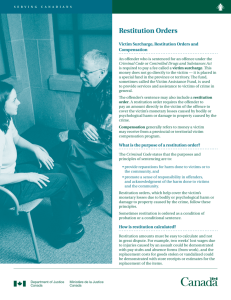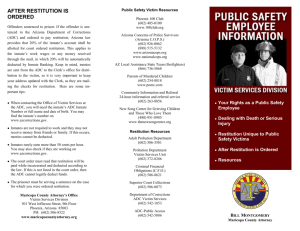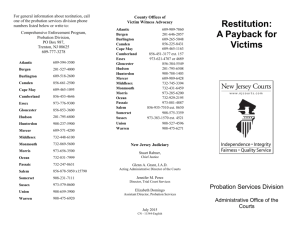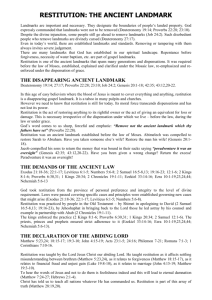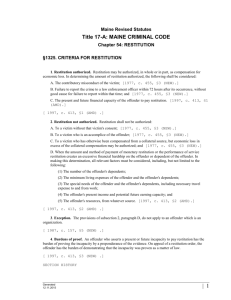Chapter 5 - The Victims' Assistance Legal Organization (VALOR)
advertisement
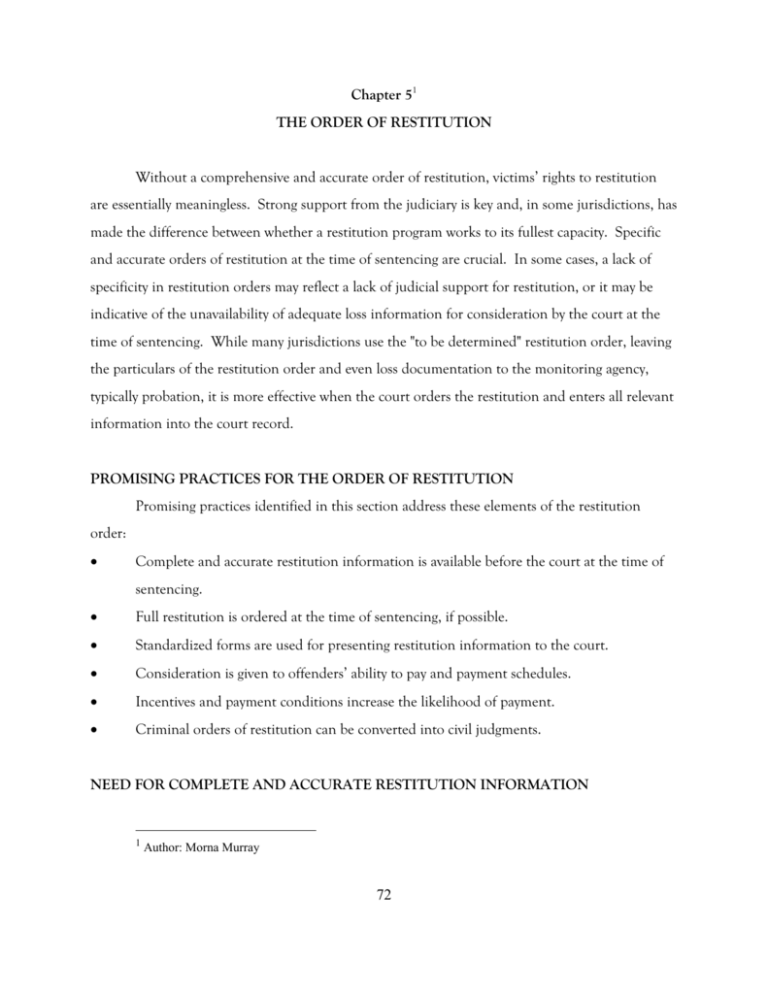
Chapter 51 THE ORDER OF RESTITUTION Without a comprehensive and accurate order of restitution, victims’ rights to restitution are essentially meaningless. Strong support from the judiciary is key and, in some jurisdictions, has made the difference between whether a restitution program works to its fullest capacity. Specific and accurate orders of restitution at the time of sentencing are crucial. In some cases, a lack of specificity in restitution orders may reflect a lack of judicial support for restitution, or it may be indicative of the unavailability of adequate loss information for consideration by the court at the time of sentencing. While many jurisdictions use the "to be determined" restitution order, leaving the particulars of the restitution order and even loss documentation to the monitoring agency, typically probation, it is more effective when the court orders the restitution and enters all relevant information into the court record. PROMISING PRACTICES FOR THE ORDER OF RESTITUTION Promising practices identified in this section address these elements of the restitution order: Complete and accurate restitution information is available before the court at the time of sentencing. Full restitution is ordered at the time of sentencing, if possible. Standardized forms are used for presenting restitution information to the court. Consideration is given to offenders’ ability to pay and payment schedules. Incentives and payment conditions increase the likelihood of payment. Criminal orders of restitution can be converted into civil judgments. NEED FOR COMPLETE AND ACCURATE RESTITUTION INFORMATION 1 Author: Morna Murray 72 Clearly, the goal of having complete and accurate information before the court at the time of sentencing (or when a plea is entered) is inseparable from the recommendations espoused in the previous chapter regarding the role of the prosecution in documenting victim losses vis-a-vis restitution. In response to the survey question, "Is restitution information routinely gathered prior to sentencing?": 81% of adult program respondents indicated that it was routinely gathered; and 56% of juvenile program respondents indicated that it was routinely gathered. This is good news for victims and indicative of the fact that a majority of jurisdictions, at least in this survey, are gathering restitution information prior to the sentencing phase. However, it should be noted that even in those jurisdictions that routinely gather restitution information prior to sentencing, it is frequently incomplete, partly due to frequent fast-tracking of criminal cases and the practical difficulties of assessing long-term losses, prior to sentencing. Figure 5a demonstrates the survey responses to the question of which criminal or juvenile justice agency is actually responsible for presenting the restitution information to the court. 73 As can be seen from the graph, the clear majority of respondents indicated that the prosecution is responsible for presenting such information to the court, followed by adult probation. In response to whether a written protocol (e.g., a restitution plan) is submitted to the court at the time of sentencing, only 34% of the respondents indicated that such a plan was used, and 49% responded that no written protocol was used (18% indicated that this factor was unknown). Use of a specific and comprehensive written form, such as a restitution plan, or an agreed order that is prepared for the court, is an essential tool for this stage of the restitution process. In Alexandria, Virginia, staff members from the Commonwealth’s Attorney’s Victim Witness Assistance Program routinely contact victims when criminal charges are filed to obtain all pertinent information, including information regarding losses for which restitution may be ordered. Prior to sentencing, a Restitution Plan is completed, containing the following information: defendant name and social security number; victim name and address; criminal case number; total amount of restitution ordered; payment schedule; and date for payment. The Virginia Code actually mandates the use of the Restitution Plan, providing as follows: Sec. 19.2-305.1(B). At or before the time of sentencing, the court shall receive and consider any plan for making restitution...the plan shall include the defendant’s home address, place of employment and address, social security number and bank information... Types of payment that will be accepted for restitution are spelled out on the face of the plan, as is the mailing address for the Clerk of Court, to which all payments are directed. To protect the victim’s confidentiality, the restitution plan form is printed in a multicopy format, with all victim information redacted on the copies for defense counsel and defendant. Defendants are also strongly encouraged to make an initial payment at the time of sentencing. Exhibit 5a shows the Alexandria, Virginia Restitution Plan. 74 75 76 77 As seen in the above example, the use of standardized forms for the presentation of restitution information to the court is a very simple and straightforward way to streamline the processing of restitution information. In fact, interviews during the course of this project repeatedly illustrated the fact that even seriously underfunded jurisdictions are realizing that it does not necessarily take extra funding to make significant progress toward improving the likelihood of payment of restitution. Straightforward Solutions to a Complex Problem In some of the rural judicial districts in Arkansas, the success of restitution collection depends a great deal on the initiative and commitment of individuals in the participating agencies. Victim/Witness Assistance coordinators in district attorneys’ offices in Arkansas are filling in some of the gaps in the restitution collection process in their counties. In Miller County, Arkansas (population 86,000) the Clerk in the Circuit Court collects restitution, but lacks a database that monitors the ordering and payment of restitution and therefore often lacks the information regarding to whom and where to send the collected monies. At the same time, victims frequently have difficulty accounting for all of their losses at the time of disposition so that the restitution ordered is “to be determined” and tends to remain so until long after the offender has been released from custody. To assist victims in applying for restitution in a timely manner, Beth Kemp, the Victim/Witness Coordinator at the Miller County District Attorney’s Office developed a special questionnaire for victims that helps them determine what property may have been lost or damaged with special emphasis on items that are commonly overlooked. She makes every effort to see that an appropriate amount of restitution can be ordered for the victim at the time of sentencing. (B. Kemp, personal communication, October 25, 1999). Ms. Kemp has also created a restitution report that she delivers to the Clerk of Courts at the time of sentencing to inform him of the recipient’s name, the amount owed, and the address where the check should be mailed. Having established the restitution report as a protocol within her office, she now finds that the clerk asks for the reports, has incorporated them into the 78 procedure for monitoring restitution, and is thus improving the distribution of collected restitution in general. In King County, Washington, the Adult Felony Victim Assistance Unit (VAU) of the Prosecutor’s Office is responsible for all information gathered regarding victim losses and restitution and, in most cases, prepares the order of restitution for submission to the judge. Once a defendant is found guilty or pleads guilty, restitution investigators for the VAU finalize the restitution information (which had earlier been gathered and entered into a county database), contact victims for any missing information, and prepare the proposed restitution order. On some occasions, particularly those involving third-party victims, such as insurance companies or financial institutions, the information may not be final at the time of sentencing and so the entire file is returned to the VAU until such time as all information is available and submitted. VAU tracks and monitors the loss information until it is complete. The full amount of restitution is regularly sought and ordered, including often overlooked expenses such as insurance premiums paid by victims on policies covering losses. For example, in the case where a victim’s stereo equipment, valued at $400, was stolen, restitution would be sought in the amount of $400 for the insurance company that reimbursed the victim, as well as $100 to compensate the victim for payment of the insurance deductible. (C. Hendrix, personal communication, November 1, 1999). CONTENTS OF THE RESTITUTION ORDER Again, the restitution order should be as comprehensive and complete as possible. However, the challenges facing the judiciary in the reasonable and effective ordering of restitution to victims of crime depends on many factors. Victim Restitution: A Priority for Justice, (APPA etc.) a recent study that analyzed restitution procedures within the courts nationwide, makes the following recommendations: · Judges should order restitution of all sentences in criminal and juvenile court, including diversion, probation, and incarceration/detention. 79 · An offender’s inability to pay restitution at the time of sentencing should not be construed as reasonable cause to refuse to order restitution. Current and projected earnings for the future must be considered. · If a judge fails to order restitution, he or she should state for the court record his or her reason for doing so, and provide this explanation directly to the victim. · The court should request and consider victim impact statements and presentence investigation reports from probation officials that contain documentation relevant to restitution. · Judges should consider the full range of remedies available to both the court and to victims in the event that an offender fails to comply with the restitution order. The court should provide written resources to victims that offer an overview of this vital information. · The court (or in some jurisdictions, the prosecutor or probation office) should notify victims of the date of the sentencing hearing, and encourage their attendance and participation · The court can order that bail money paid by the offender be directly applied to victim restitution obligations, instead of being returned to the offender. · When cases are returned to court for an offender’s failure to fulfill his or her restitution requirements, the judge should seek input from the victim and consider the full range of remedies the court can take to facilitate offenders’ compliance with its order. 80 · In cases resulting in incarceration or detention, documentation of restitution obligations should be included in the offender’s case file for review by paroling authorities. It is essential for all parties to the restitution process to understand that the order of restitution will serve as a blueprint of sorts for the victim’s recovery. Minimally, the order of restitution should reflect the following: Total amount of restitution; Whether an initial payment is required at sentencing (or entry of the plea); If there is to be a payment schedule, amount of payments and due dates; For cases involving multiple victims, allocation and priority of restitution payment among victims; For cases involving multiple defendants, whether the liability is joint and several (should be), and the specific amount of restitution owed by each defendant, with individual payment plans, if necessary; Priority of payment of restitution in relation to other court-ordered payments, (e.g., restitution fine, court costs, support payments, etc.); and Potential sanctions for failure to make a restitution payment. A common practice is for a court to enter a restitution order, leaving the establishment of the payment schedule for determination by probation. This can lead to a variety of problems, one of which is illustrated by a recent Vermont case. In State v. Guinard, 726 A.2d 88 (Vt.Sup. 1999), the state sought to revoke the defendant’s probation when she failed to pay restitution in accordance with a payment plan she entered into with her probation officer. The court of appeals held that since the trial court had entered an order of restitution but had failed to set installment payments, the defendant could make restitution payments at any time during the probationary period, regardless of the contract she made with the probation officer which detailed a specific payment plan. 81 As a final consideration regarding orders of restitution, it is absolutely crucial that jurisdictions have legislative authority, court rules, statutory authority or some other form of enabling provision that allows for the modification of restitution orders in the event that victims’ expenses cannot be known at the time the order is entered, or if the financial situation of the offender undergoes some kind of change for the better. Responses to the survey indicate about a 50/50 split in jurisdictions as to whether they have procedures in place for the modification of restitution orders. While a variety of methods by which restitution orders can be subsequently modified were described, statutory or constitutional authority provides the greatest and most consistent protection to victims. Exhibit 5b shows a sample order of restitution for Kay County, Oklahoma. 82 83 84 PRACTICAL POINTERS FROM THE TRENCHES Deborah Lee, Coordinator of the Victim Assistance Unit (VAU), Juvenile Section, in King County, Washington, developed The Deputy Prosecuting Attorney Courtroom Handbook: Victim Rights and Restitution in the Juvenile Court. This comprehensive manual designed for reference and use by deputy prosecuting attorneys addresses every aspect of state and jurisdictional authority, case law, policies and procedures as such relate to restitution. Topics include: Advocate Notes Drafting of Agreed Restitution Orders Victim Bill of Rights Child Victims and Witnesses State Constitutional Rights Crime Victims Compensation Definition of a Victim Mediation and Private Restitution Agreements Recovery Options Outside Juvenile Court (civil actions, small claims court) Restitution Case Law Restitution Rights Restorative Justice Victim Participation Rights A section entitled "Restitution Tips," includes the following pointers for prosecutors regarding restitution orders: 1. If the victim advocate is present in court, introduce him/her and have the advocate present the loss information. 85 2. If the court is convinced that some of the loss should be ordered, but is unsure about a part of it, have the court order the part it’s sure of, and set a restitution hearing for the remainder. 3. If all medical/counseling costs are not yet complete, ask the court to leave restitution open, ordering amounts already incurred. 4. If an appeal of restitution looks likely, have all restitution documents entered into evidence. 5. If the court sets restitution over for another hearing, please identify all issues in your notes. 6. The victim’s presence is not required at a restitution hearing and the judge cannot order them to be present. 7. When the court will not order restitution in full due to the offender’s inability to pay, have the court state for the record the full amount of the victim’s loss. This may be useful if the victim sues civilly. Always ask the basis for the court’s restitution decision. The victim will want to know. Also consider a Motion for Reconsideration. 8. At disposition, if the defense requests a restitution hearing, argue against it and ask the court to set the amount if: (a) we do have all adequate information; and (b) the defense has had the discovery a reasonable length of time and is now throwing out unfounded assertions. It is better practice for the court to enter a restitution order and let the defense come back and contest it if they uncover new evidence, than to set the whole matter over. 86 9. At modification hearing, argue against restitution being waived in lieu of detention time served. Waiving it only rewards the offender for refusing to comply and further penalizes the victim. It should also be noted that the state of Washington has extended jurisdiction over juveniles who owe restitution for a period of ten years after the age of eighteen, or through the age of twenty eight (RCW 13.40.145 and RCW 13.40.190(1)). Conversely, in many states, an order of restitution against a juvenile offender is no longer valid once the juvenile reaches the age of majority in that state. CONSIDERATIONS INVOLVING OFFENDERS’ ABILITY TO PAY AND PAYMENT SCHEDULES Much debate has occurred around the ability of offenders to pay restitution. For many years, the perceived incapacity of the majority of offenders within the criminal and juvenile justice systems to manage the payment of restitution was enough of a deterrent to many prosecutors and judges to make the remedy of restitution seemingly "not worth it." Fortunately, this attitude is increasingly waning. More and more support is developing among all players in the criminal and juvenile justice systems for the firm belief that restitution orders should reflect the full amount of loss and the only thing that should be affected by an offender’s ability to pay is the payment schedule. Mel Wilson, the Davis County, Utah Attorney and Chairman of the Restitution Study Committee asks the question, “Why are we cutting them a good deal and not addressing restitution? If I am going to reduce somebody from a second degree felony down to a third degree felony, part of the consideration should be that this person is going to pay full restitution for X amount of dollars” (M. Wilson, personal communication, October 28, 1999). This is supported by the responses to the survey: 73% indicated that restitution orders routinely reflect the full amount of loss, while only 15% responded that orders do not reflect the full amount of loss (12% were unsure). 87 Stipulations in Restitution Orders that Increase the Likelihood of Payment In the District Attorney’s Office, Eighth District, Newkirk, Oklahoma, the Victim Witness Coordinator cites "judicial backing with victim restitution a priority in order of collection" as one of the strongest aspects of the restitution program. The district judge developed guidelines for the payment of costs, fines and restitution, which provide the following requirements: In felony cases where the total amount due (court costs, fines assessments, restitution) is less than $300, the total amount due shall be paid in full upon sentencing. No payment plan shall be allowed. In felony cases where the total amount due exceeds $300 and the defendant is financially unable to pay the total amount due at the time of sentencing, a payment plan may be developed requiring a minimum initial payment and monthly payments thereafter in accordance with the following schedule: Total Sum Due Minimum Initial Payment More than $300, but less than $1,000 $300 More than $1,000, but less than $2,000 25% More than $2,000, but less than $4,000 20% More than $4,000 15% Monthly payments shall be tailored to the financial ability of the individual defendant. However, no payment plan shall provide for a minimum payment of less than $100 per month [italics added]. In appropriate instances, the defendant may be granted a twenty-four hour stay of execution to present payment of the minimum sums due the court. 88 The rules set forth herein are guidelines that will apply in the vast majority of cases. However, extenuating circumstances may require modification of these guidelines in rare cases. 89 PRIORITY OF RESTITUTION PAYMENTS With the exception of court-ordered child support payments, individual victims should receive restitution payments first, ahead of other court costs, fines, or other justice system fees. Nearly half of the survey respondents indicated that individual victims received first priority in the payment of restitution, but court costs and fines are still routinely collected as a first priority, ahead of restitution, in many jurisdictions. The top three responses in order of priority were: Individual victims; Businesses; and Third-party victims (e.g., insurance companies, financial institutions) Some states have taken the step of statutorily establishing the order of priority of court- ordered financial obligations. Examples of statutory provisions from two states, Florida and Florida (F. S. 1995, Ch. 948, Probation and Community Control, p. 2059) (7) The department shall establish a payment plan for all costs ordered by the courts for collection by the department and a priority order for payments, except that victim restitution payments authorized under s. 948.03(1)(e) take precedence over all other court-ordered payments [italics added]. Wisconsin, are shown in Exhibits 5c and 5d: 90 (Wis. Wisconsin Stat. 973.20, Sentencing, p. 5266-5267) (1r) . . .[T]he court. . . shall order the defendant to make full or partial restitution under this section to any victim of a crime considered at sentencing or, if the victim is deceased, to his or her estate, unless the court finds substantial reason not to do so and states the reason on the record. Restitution ordered under this section is a condition of probation or parole served by the defendant for a crime for which the defendant was convicted. . . . (12b) Except as provided in par. (c), payments shall be applied first to satisfy the ordered restitution in full [italics added], then to pay any fines or related payments under s. 973.05, then to pay costs other than attorney fees and finally to reimburse county or state costs of legal representation. Moreover, some states have established legislation that provides for payment of restitution (and other court costs, fines, etc.) out of an inmate’s trust fund. Exhibit 5e contains a statute from the state of Montana providing that anytime an inmate has a balance in excess of $200, the excess will be forfeited for the payment of restitution. It also provides Montana (Section 1. Limits on inmate financial transactions.) (1) An inmate of the Montana state prison in Deer Lodge or the women’s correctional system in Billings shall use the prison inmate trust account system administered by the department of corrections to send money out of or receive money in the facility. . . If an inmate accumulates a balance in excess of $200 in the inmate’s prison inmate trust account, the excess must, consistent with department rules, be forfeited for the payment of restitution or costs of incarceration. . . . (2) (a) Money forfeited under subsection (1) to the payment of restitution must be paid in the following order: (i) to the victim until the victim’s unreimbursed pecuniary loss is satisfied; (ii) to the crime victims compensation and assistance account provided for in 53-9-109 until the account is fully reimbursed for compensation to the victim; (iii) to any other government agency that has compensated the victim for the victim’s pecuniary loss; (iv) to any insurance company that has compensated the victim for the victim’s pecuniary loss [italics added]. for the priority of payment of forfeited monies, with victims occupying first priority. 91 CONVERTING CRIMINAL ORDERS OF RESTITUTION INTO CIVIL JUDGMENTS While the management and collection of restitution is undergoing a tremendous revitalization and reprioritization in hundreds of jurisdictions around the country, the reality remains that many victims never see the restitution to which they are entitled legally. The civil justice system offers them the hope of enforcing a civil judgment against the offender through forfeiture or levy against the offender’s real or personal property. There are some potential drawbacks to this avenue of recovery, most notably that victims may have to undergo the expense of hiring a private attorney to navigate the civil system on their behalf. Increasingly, states and jurisdictions are taking steps to ensure that a criminal order of restitution can automatically be converted into a civil judgment, potentially saving victims (known as plaintiffs in the civil system) time, money, and aggravation. It is still the responsibility of the victim to pursue collection of the civil judgment, but jurisdictionally mandated conversion of criminal orders can go a long way toward simplifying the process, or at least toward getting it started. One of the questions in the survey conducted for this project asked whether a civil judgment was entered at the time of a criminal order of restitution. Respondents answered as follows: No -- 54% Yes -- 29% Unknown -- 17% The availability of civil remedies has only recently become a focus in terms of educating victims about their potential avenues of recovery. Interestingly, many prosecutors have questioned whether it is even legitimate for them, or members of their staff, to discuss civil remedies with victims. In response to an inquiry as to whether it is ethical for prosecutors to inform a crime victim of possible civil remedies, the Standing Committee on Professional Responsibility and Conduct of the State Bar of California issued an opinion that such action may be taken properly, providing, in part, as follows: . . .It is the Committee’s opinion that information regarding civil remedies properly may be provided to the crime victim by the prosecutor in response to the victim’s 92 inquiry. Further, the prosecutor may volunteer the information, absent improper motives. . . It is improper for the prosecutor to volunteer the information, however, when he is motivated by a desire for publicity or a desire to harass or injure the criminal. (Cal 1976-40, Formal Opinion No. 1976-40, Victims’ Rights Manual, Institute for the Advancement of Criminal Justice, California District Attorneys Association, and the California State Board of Control). Recent case law also indicates a willingness by the courts to protect the rights of crime victims to pursue their civil remedies without jeopardizing their right to a criminal order of restitution. In State v. Walters, 591 N.W.2d 874 (Wis.App. Feb. 1999), the court held that a victim’s agreement to settle a civil action with a criminal defendant does not preclude a court from ordering restitution in reference to the defendant’s crimes. In Urias v. State, 987 S.W.2d 613 (Tex.App. Feb. 1999), the court held that the victim’s settlement with the defendant’s automobile insurer did not preclude the trial court from ordering the defendant to pay restitution in full. The court stated in part, "The law will not tolerate privately negotiated end runs around the criminal justice system." The court also rejected the defendant’s claim that the negotiated civil settlement established the maximum amount of restitution that could be ordered (Probation and Parole Law Reports, 1999). HOW THE JUSTICE SYSTEM CAN HELP In Santa Barbara County, California, a specific pleading form was developed for court orders of restitution that is then converted into a civil judgment when the case ends. Victims are notified of the conversion by letter and informed that they can also pursue their legal rights within the civil system. In the juvenile system, civil judgments are generally much more difficult to obtain (due to restrictions in civilly suing a minor). However, in Pima County, Arizona, criminal orders of restitution automatically convert to a civil judgment when the juvenile reaches the age of eighteen. Victims and offenders are notified of this conversion and the civil judgment is good until such time as the restitution is paid. 93 94 95 The California State Board of Control publishes a pamphlet entitled How to Enforce Your Restitution Order as a Civil Judgment. This pamphlet was written for victims and comprehensively sets forth the specific procedures for: (1) converting to a civil judgment; (2) finding out what the offender (debtor) owns; and (3) collection options, in the form of liens and writs of execution (to levy on various types of property of the offender, including wage garnishment). A copy of the brochure is shown in Exhibit 5f. Currently, Utah law provides that restitution after parole has been 96 completed becomes an automatic civil judgment, obliging the victim to hire an attorney and collect the monies owed for restitution directly from the offender. While the Restitution Advocate is part of an initiative in Utah to modify the law to allow for unsupervised probation for as long as offenders owe restitution and therefore continue the collection process through parole and probation, the office has developed a protocol and a brochure to assist victims in this circumstance. When the offender is approaching the end of his or her sentence, the Board of Pardons notifies the victim of the end of custody and sends out a brochure that explains the options they can take to collect on a judgment or provide motivation for the offender to pay. These options include the garnishment of wages and state tax refunds, attachments to bank accounts, and the suspension of driver’s licenses. At the same time, the Restitution Advocate is available to consult directly with the victim as they embark on the civil stage of the restitution process. A brochure on potential civil remedies and practical pointers for navigating the civil justice system in a particular jurisdiction can prove absolutely invaluable to victims. The time it takes to prepare a simple informational pamphlet can save thousands of victims innumerable hours and untold expense in the exploration and instigation of their civil remedies. It can make the difference between victims pursuing their civil remedies or simply giving up hope that the criminal, juvenile, or civil justice system can dispense justice. One victim’s story of tenacity and sheer willpower in pursuing his legal remedies within the civil justice system after the offender refused to pay court-ordered criminal restitution is a unique example of what can happen in the pursuit of a civil judgment. The California courts ordered the man who defrauded Martin Plone of his life’s savings in a Ponzi scheme to pay $1,000,000 of restitution. The offender, who was sentenced to five years in jail, had no visible assets. As a result, Plone determined that he would have to sue in civil court and pursue third party liabilities if he wished to regain a portion of his savings. He was fifty-one years old, single with no dependents, and had a prosperous veterinary practice to support his effort (M. Plone, personal communication, October 14, 1999). It should be pointed out that while Plone may be somewhat typical of an individual defrauded in a white collar crime, few victims would have his unique resources at hand to pursue a 97 long civil court battle. Plone hired an attorney and initiated a civil proceeding against the offender for pecuniary damages and a proceeding against the title companies that had inadvertently participated in the fraud. The offender, having forged Plone’s signature on several documents in order to complete the fraud had inculpated both the banks and title companies in his crime. Plone realized that the participating institutions would be insured to protect themselves from this kind of illegal behavior. After spending $100,000 in attorney bills, however, Plone also realized that the same insurance institutions would fight his lawsuit as long as it was cheaper to defend themselves than it was to settle the lawsuit. He could no longer afford to pay his attorney, so for the next few years, he represented himself as attorney in thirteen out of fourteen motions. He spent every weekend in the library looking up case law and familiarizing himself with California’s statutes, and he estimates that his personal legal expenses by the end of the effort amounted to $200,000. Plone has been successful on several accounts. The institutions settled on the first day of trial for $350,000. He won a civil judgment of $2,000,000 against the offender. The interrogatories filed at the time of the offender’s parole revealed ownership of properties through limited partnerships that Plone was able to foreclose upon. After a long battle, he also recovered $80,000 through the California Department of Real Estate Recovery, a fund set up to assist victims of real estate fraud for amounts up to $100,000. One year after the offender was released on parole, he began making payments to Plone of $300 a month in the form of a money order and has never missed a payment. Today, Plone has recovered $700,000 of the $1,000,000 stolen in the fraud and he feels that the restitution has provided him with a certain amount of closure. He admits that the motivation to work hard to recover the money was financial. “I was broke and I had not worked all my life for nothing. I was determined to get something back.” A criminal order of restitution can be accurate, complete and specific, or it can be less than adequate. Although legitimate reasons can and do exist for not presenting all loss information to the court at the time of sentencing (or plea bargain), it is, nevertheless, a reality in many jurisdictions that such failure is, among other things, due to negligence, lack of due diligence, lack 98 of priority upon victim concerns, or simply duties “falling through the cracks.” Innovative practices for ensuring the entry of an accurate and just order of restitution abound, and jurisdictions are increasingly assisting victims with the entry of civil judgments, or with at least the knowledge that they have options within the civil system for the recovery of unpaid criminal restitution. 99

